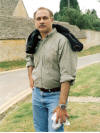|
|
the-south-asian.com July / August 2006 |
|
|||
|
August/September Contents
Sufis - wisdom against 50
years of mountain Heritage cities:
Cotton - the fibre of
|
|
||||
|
Page 4 of
10 Telecom & Software - Trends & Future in South Asia
(cntd.) by
First published in
December 2001 Jewel in the Crown - Sam Pitroda’s C-DOT
Originally from Orissa , Pitroda lives in a suburb of Chicago, Illinois.
Value / Wealth created in 1980, $10 million in U.S..
Later on went on to create C-DOT valued in 2001 for India’s Telecom
Ministry in at least 1-5 Billion Dollars.
In
1984 Sam Pitroda, silver haired, introduced himself to an audience of Saudi
American Bank [Citibank] in Jeddah’s Hyatt Hotel as a venture capitalist .
At that time very few understood what this term meant. He had sold his
telephone exchange company to Rockwell for about $ 10 million and had been
picked up by the Indian Prime-Minister Rajiv Gandhi to start a new public
sector venture called Center for the Development of Telematics [C-DOT] .
Pitroda successfully embarked upon the creation and launch of Rural
automatic telephone exchanges [ RAX] designed and produced by his team of
Indian engineers. This was against all the rivalries and the intense fight
against him conducted by various Ministries of Telecom and Bureaucrats in
the public Telecom sector and the Multinational players [ Siemens , Alcatel,
Ericsson] in the private sector. He was even accused of being a CIA agent by
the Indian press.
Today the work of Sam Pitroda has resulted in RAX of up to 200 telephone
lines. Urban Towns requiring 40,000 lines are also produced . They come
complete with SS7 Intelligent Network signaling systems [ these are the
systems that are used to find out if a number is busy or available and
involve a separate system that checks up the data bases of phone numbers ;
also they provide toll-free services; in this way a the main telephone
network does not get overloaded ; these systems are also used to
interconnect Mobile and land based telephone numbers]. In addition ISDN
facilities are also available ; what is unique is that these switches have
been designed to operate without air- conditioning in harsh environments.
|
|||||
|
Copyright © 2000 - 2006 [the-south-asian.com]. Intellectual Property. All rights reserved. |
|||||

